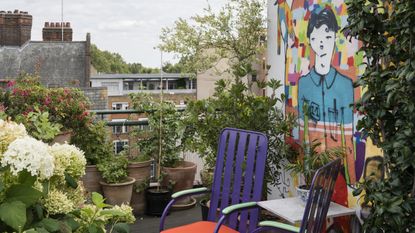Garden expert reveals how to create a biodiverse space on a city-center balcony
It is possible to create a biodiverse garden on your balcony or terrace – this expert shows us how it’s done


The appeal behind a biodiverse garden is unending – these spaces not only benefit the local habitat but our wellbeing, too. However, just because you live in a small urban area doesn’t mean you need to miss out on all the fun.
Cue Frances Tophill, the celebrity garden expert and TV presenter, bringing biodiversity to modern gardens of all sizes – from a lush country patch to a small window balcony overlooking the cityscape. In an exclusive interview with Livingetc, Frances revealed how to create a biodiverse space in a small urban apartment – and we’re rushing to follow her ingenious advice.
How do we create a biodiverse space in a small urban apartment?

‘In urban areas, there are so many little gardens - whether it’s a balcony or a windowsill or a tiny little courtyard. So, there is a real opportunity for people to make a massive difference to wildlife survival,’ Frances begins.
‘You have to think of your little garden being a part of a larger habitat. Your garden could be a tiny patch, but if your neighbors are doing it, then you end up with a whole host of little gardens where the wildlife can find a haven,’ she adds.
So what steps can we take as individuals to makes sure we're contributing to this larger habitat from our city center balconies?
Use your vertical space

See: Roof garden ideas: 21 fun and stylish ideas to make the most of your rooftop garden
‘Use the vertical space. Grow climbers, especially things that are good for pollinators and good for nectar, such as honeysuckle or passion flowers. Maybe even some spikes or very thin hedge plants that you can tie in that give the birds a nest where they are safe from cats and dogs,’ Frances shares.
Introduce water wherever possible
Perhaps the quickest way to promote biodiversity is bringing in water that will particularly make a difference for the birds who will have a space to wash and drink. ‘Everything needs water to survive. The crucial thing about bringing water in is that loads of insects have part of their life cycle under the water.'
'You will really increase the amount of wildlife and different species that you can cater for in your garden,' she adds.

Choose your plants wisely
‘With everything that you’re planting, make sure you’re thinking about how it will benefit the wildlife,’ Frances explains. ‘Never choose bedded plants that have double flowers because they are infertile. Always make sure that you’re picking plants that have accessible nectar because, in a small space, every single plant counts.'
‘Choose things like climbing roses, which is a really nice thing to do in a wildlife-friendly small garden, because they grow vertically and have a few spikes which can provide nesting for birds. Make sure you choose roses that grow rose hips in the winter. On a small scale, every single plant that you choose counts,’ Frances adds.

See: The Balcony Gardener shares her five simple steps to a successful balcony garden
Now we have no excuse not to embrace the wild side – wherever we are.
Feeling inspired? Frances has teamed up with Weleda - the original green beauty brand - to encourage people to reconnect with nature and support biodiversity through its #GetGreenFingers campaign. For more information, visit their website.
Be The First To Know
The Livingetc newsletter is your shortcut to the now and the next in home design. Subscribe today to receive a stunning free 200-page book of the best homes from around the world.
Megan is the News and Trends Editor at Homes & Gardens. She first joined Future Plc as a News Writer across their interiors titles, including Livingetc and Real Homes. As the News Editor, she often focuses on emerging microtrends, well-being stories, and celebrity-focused pieces.
Before joining Future, Megan worked as a News Explainer at The Telegraph, following her MA in International Journalism at the University of Leeds. During her BA in English Literature and Creative Writing, she gained writing experience in the US whilst studying in New York. Megan also focused on travel writing during her time living in Paris, where she produced content for a French travel site.
-
 These 12 Best Table Lamps for Your Desk — Perfect Glows for a Creative Home Office
These 12 Best Table Lamps for Your Desk — Perfect Glows for a Creative Home OfficeThe best table lamps for your desk is have a soft, targeted glow. Elevate your WFH set-up with these stylish picks endorsed by Style Editor Brigid Kennedy
By Brigid Kennedy Published
-
 The Nespresso VertuoPlus is 30% Off for President's Day, and it's Kim Kardashian's Coffee Maker of Choice
The Nespresso VertuoPlus is 30% Off for President's Day, and it's Kim Kardashian's Coffee Maker of ChoiceThis sleek and stylish coffee maker was spotted in Kim's home bar, and you can currently save $60 if you buy yours from Amazon
By Lilith Hudson Published

